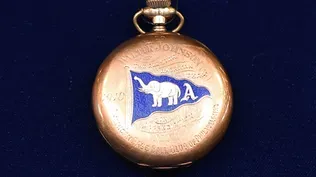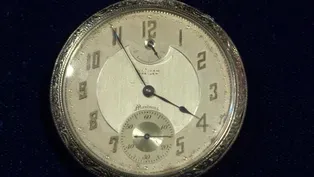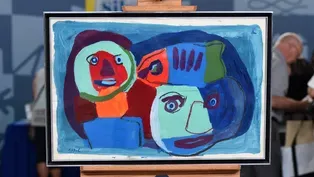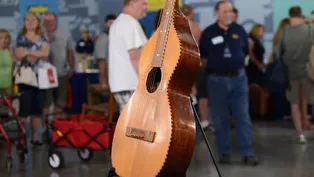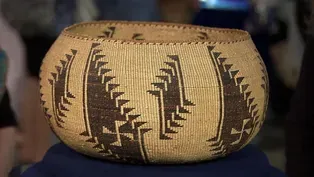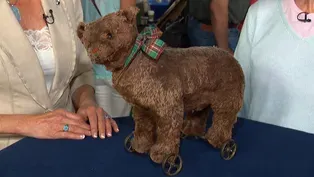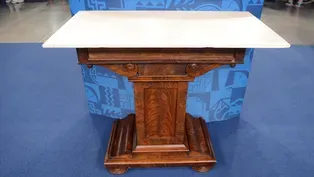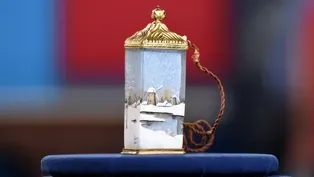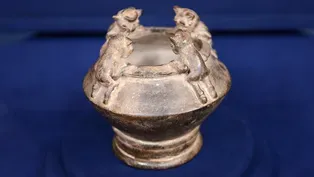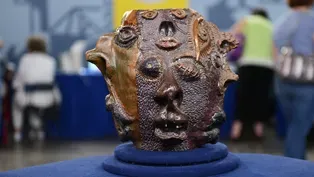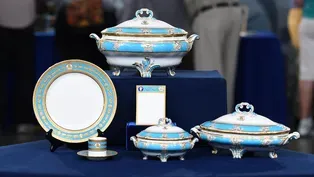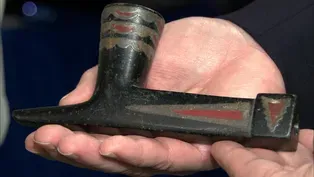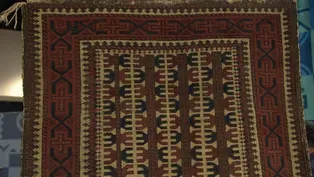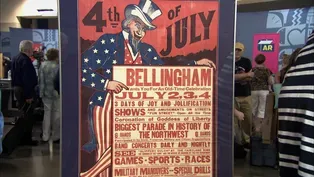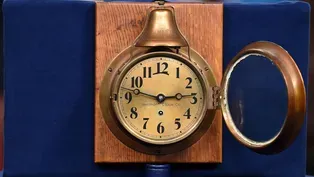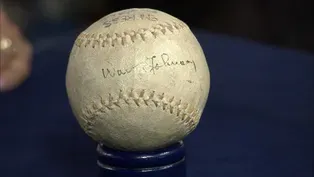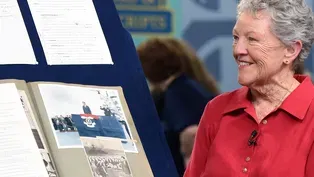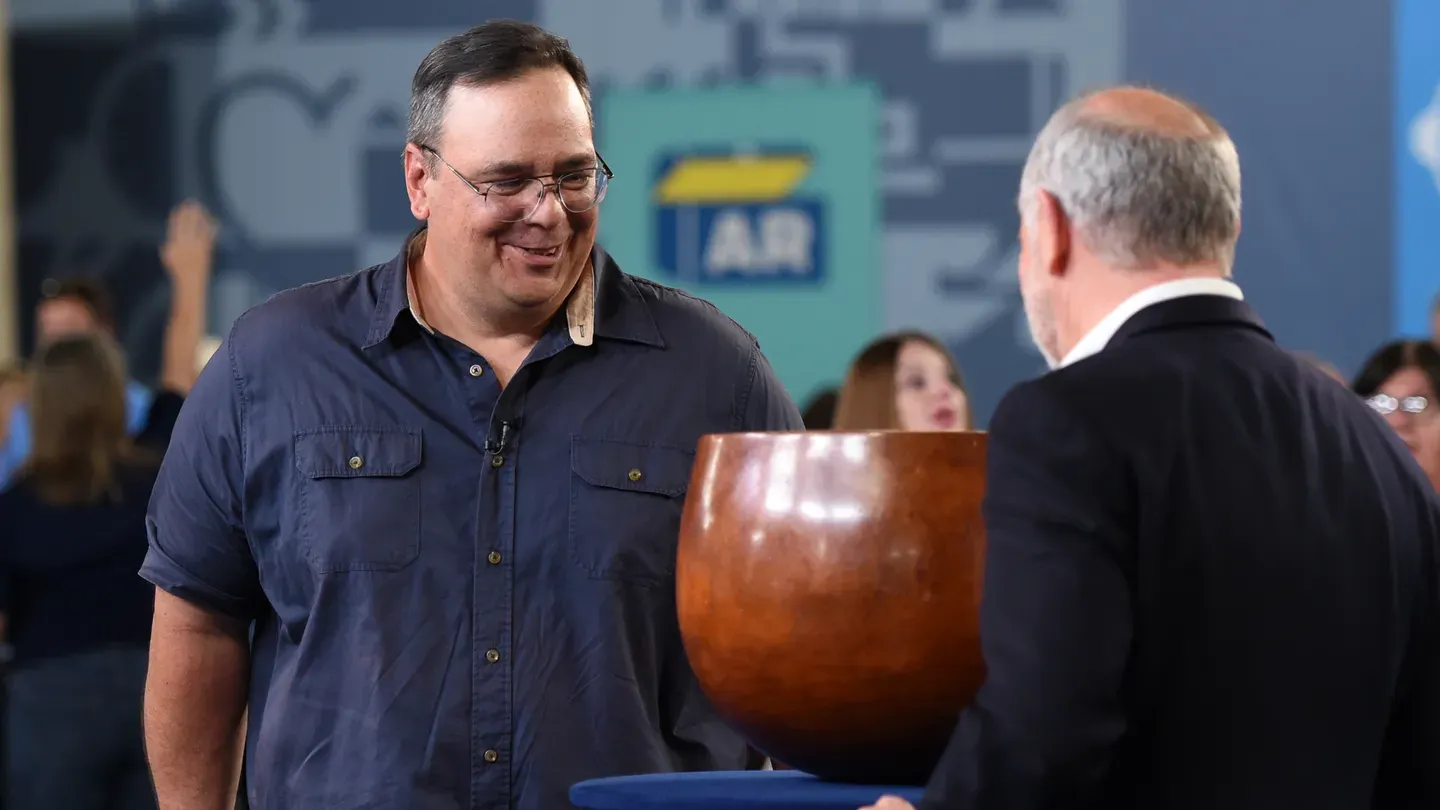

Spokane, Hour 2 (2016)
Season 20 Episode 2 | 53mVideo has Closed Captions
A JFK archive, a grotesque face jug, and "Gone with the Wind" sketches. One is $60K-$80K!
Discover fantastic finds in Spokane including a 1961-1963 JFK archive, a grotesque face jug, and "Gone with the Wind" sketches. Can you guess which is valued at $60,000-$80,000?
Problems with Closed Captions? Closed Captioning Feedback
Problems with Closed Captions? Closed Captioning Feedback
Funding for ANTIQUES ROADSHOW is provided by Ancestry and American Cruise Lines. Additional funding is provided by public television viewers.

Spokane, Hour 2 (2016)
Season 20 Episode 2 | 53mVideo has Closed Captions
Discover fantastic finds in Spokane including a 1961-1963 JFK archive, a grotesque face jug, and "Gone with the Wind" sketches. Can you guess which is valued at $60,000-$80,000?
Problems with Closed Captions? Closed Captioning Feedback
How to Watch Antiques Roadshow
Antiques Roadshow is available to stream on pbs.org and the free PBS App, available on iPhone, Apple TV, Android TV, Android smartphones, Amazon Fire TV, Amazon Fire Tablet, Roku, Samsung Smart TV, and Vizio.
Buy Now

ANTIQUES ROADSHOW 2025 Tour!
Enter now for a chance to win free tickets to ANTIQUES ROADSHOW's 2025 Tour! Plus, see which cities we're headed to!Providing Support for PBS.org
Learn Moreabout PBS online sponsorshipMARK WALBERG: From Spokane, Washington, it's Antiques Roadshow.
APPRAISER: People might look at this and say, "My goodness, what is this?
My child could do this."
When it spoke to you, what was it saying?
It was saying, "I'm very unusual."
Oh, my gosh.
WALBERG: Antiques Roadshow found the treasures were overflowing in this city along the Spokane River, Spokane, Washington.
Everyone who came with a prized possession had a story to share.
What possessed one Roadshow guest to snatch up this unique work of art?
Take a look.
I found it at an estate sale in Eugene, Oregon.
It was up in barn.
It was covered with dirt and straw.
Looked like some chicken droppings were on it.
It was very dirty.
I had to have it.
It speaks to me.
When it spoke to you, what was it saying?
It was saying, "I'm very unusual."
(laughs) "I'm very different."
There are grotesque face jugs out there.
In my experience, to a certain degree, they tend to be predictable, and in fact, some of them are attributable, and some of them are signed, and they even make grotesque face jugs today.
When we turn this around, there's a whole variety of, well, characters, and this particular person looks like he had an eye injury.
They've stitched his eye closed.
They all have very distinctive characters or personalities.
This person speaks with a forked tongue, it would seem.
There's a little damage here and there.
For example, this particular face looks like his tongue was stuck out at us.
So we've been spared that.
When we look at the base clay, it's red ware, and the potter has used an impressive array of techniques to come up with this extraordinary texture.
This, in its own way, is really over the top.
It's bizarre and wonderful.
You even see a little bit of, like, Pablo Picasso going on here.
It's a little difficult to identify precisely when this was made, but I think it's probably late 19th or early 20th century.
Wow.
Probably its origin, it's coast of the United States, maybe Middle Atlantic states headed southward.
Estimating its value is a little difficult.
I think in a retail setting, somebody might well ask in the area of between $30,000 and $50,000 for this.
What?!
It's...
I think it's just...
It's amazing, just an amazing thing.
No!
Well, that's my opinion.
Did you say what you paid for it?
I thought I over... excuse me.
(laughing) Excuse me, I thought I overpaid.
I paid $300 for it.
Yes, it would appear in our opinion that you didn't overpay.
(laughing) You said $30,000 retail?
Or more-- $30,000 to $50,000 or more.
I've never seen anything quite like it, ever.
Oh my God.
And I've been doing this for 20 years.
I don't know if I can walk out of here.
Well, we'll assist you if need be.
Wow.
MAN: I went up to the garage sale, I saw it up on the wall, and I thought, "Man, I'd like to have that piece."
The price on it was several hundred, I can't remember exactly how much.
Do you remember when this was?
At least 15 years ago.
And I thought about it, and I went back a couple hours later, and it was still there, and then I left again, because I still couldn't afford it.
And then I went and got my son, who was very interested in art.
And then he and this gentleman started talking, and the guy really warmed up to us and kind of just decided that we should have it, and he sold it to us for $100.
Did you know anything about it?
Well, he was telling me that it's a Katie Kolowitz.
She's from Germany, I believe.
It is by the artist Käthe Kollwitz.
She's a very important German print-maker during the first half of the 20th century, and she made several hundred woodcuts, etchings, lithographs.
This is a woodcut, and Kollwitz signed it in pencil down here.
The title of this print in German, it's called the "Gedenkblatt für Karl Liebknecht," and that's basically a memorial for Karl Liebknecht, and titled down here in pencil.
And then in this very, very, very fine script is the printer's signature.
When the armistice was signed and Germany was defeated in 1918, there was a working-class uprising in Germany, and a revolt.
Karl Liebknecht was one of the leaders of the working-class revolt, which was put down at the end of 1918.
He was arrested, and in January of 1919, while he was being taken to prison, he was killed.
And she made this print in early 1919.
And this is Karl Liebknecht at his home, laid out before his burial.
She went there, his family and friends were there.
You can see them in the background, very sorrowful faces, so this is sort of her memorial to that man.
Kollwitz was born to a fairly humble family.
Her family was somewhat political and always associated with the plight of the working class.
She was married early on, studied art, lived in Berlin.
Both of her sons joined the army, the Germany army, in the First World War, and one of her sons was killed on the western front in 1914.
And a lot of her imagery depicts the atrocities and the suffering of Germany and the rest of the world, really, in World War I and World War II.
She worked into the 1940s, and her imagery never got any happier.
It's all this vein.
Like, so how many were made?
There were a couple hundred of these, but this is an early impression.
In later printings, there was woodcut printed text, which described the scene.
There are some obvious condition issues with this work.
I would imagine for, perhaps, $500 to $700 worth of conversation work on this, it would look much, much better than it does right now.
Yeah.
In this condition, as is, at auction, I would estimate it to sell for between $4,000 and $6,000.
Really?
Now, if you go ahead and put some money into conserving it, I would put an auction estimate on it of $8,000 to $12,000.
Yeah!
So, that was a good find at the garage sale.
Yeah!
Well, it's a 00-17.
It would sell for over $2,500.
MAN: Put your hat on.
WOMAN: Put your hat on.
My little leopard skin hat and matching purse.
WOMAN: This is a baseball that was given to me by my dad.
He was born and raised in Washington, D.C., as was his father, and they used to attend the Washington Senators games back in the '20s, and I've had it since a child.
I'm embarrassed to say that it was in a basket in the garage for over 20 years at my house, along with soccer balls and basketballs and dog toys, and we were cleaning out the garage and I was ready to toss it, and my husband said, "I think we should check out this autograph and find out more about the ball."
Well, Walter Johnson, the Big Train, played all 21 years for the Washington Senators, was the most dominating right-handed pitcher of the time, and a member of the first Hall of Fame class in 1936.
The baseball, we believe, is circa 1920s.
It's not an official American League ball; it was basically a youth ball.
But what I'm most impressed about with this baseball is the condition.
It's hard enough to find a Walter Johnson single signed baseball, but to find one that's survived in this condition is incredible.
We would put a value on this, for insurance purposes, of $10,000.
Whoa, are you serious?
That's amazing.
That's great!
MAN: It's been passed down through my family, from my great-grandmother, grandmother, to my father, and then to me.
APPRAISER: And that was in Hawaii?
Yes, in Hawaii.
It's been used for quite a few things.
Right.
It was used to spin cats in, kittens, by my son.
We also used to spin in it when we were little kids, I myself.
Right.
And it's been used in a robbery to carry stuff out, and they left it behind.
And it's been used as collateral for a small loan between my mother and one of her friends.
I guess it's been used for everything except what it was made for.
And that, you think, is what?
A poi bowl that you would eat out of at a big festival, a luau.
Well, you're right, it is Hawaiian, and it is a poi bowl.
It's made from kou wood, K-O-U, which almost went extinct in the middle of the 19th century.
It has come back, but not in the sizes that would enable you to make these wonderful bowls today.
I think the bowl dates from the beginning of the 19th century.
This one doesn't have a very marked figuring on it, but it's a rather wonderful bowl, and it's above that magical 12 inches.
When the bowls get above 12 inches, they really command a serious price.
It's got some sort of surface nicks and dings, and I think that's probably due in part to the history of the bowl.
Oh, yeah.
I was looking inside, and I find that there is this repair on the bottom here.
Sometimes, that might be the weakest part in the bowl that's sort of fractured over the years.
Just off to the side there is a small butterfly-shaped repair called a peewah, and they're quite common on the bowls, which shows how much they are cared for-- that rather than throw them away when they get damaged, they really would like to fix them.
Many of the repairs that you find on the Hawaiian bowls were actually done at the end of the 19th century, the turn of the century, and done by German, Austrian, and Japanese furniture makers.
There are some which have ones that are almost signature repairs on them, and you can track them down.
It's a beautifully designed bowl, the proportions are wonderful, it's hand carved, hand turned out, not on a lathe, and it's wonderful.
As it just comes up a little bit here, it just turns out ever so slightly.
So aesthetically, it's very, very beautiful indeed.
I think a conservative retail value would be between $18,000 and $20,000 at this moment, and I think that's conservative.
It's lovely; it's a great bowl.
Thank you, thank you, it's got a long life yet.
They were actually my father-in-law's, and he was a sketch artist.
Gone with the Wind was one of the movies, several movies, that he's done.
These two particular ones were the ones I chose to come with me today, but we have several other ones.
Different artists, as well.
I'm sure everyone knows the 1939 film Gone with the Wind.
Not only did it win best picture, Vivien Leigh won best actress.
They started pre-production in 1936, and the pre-production sketches are such an important part of this movie because they were the vision of David O. Selznick and how to put this mammoth film together.
And so here, you have this one signed, "Joseph Hayes Goodwin," and dated 1939, and this one of the burning of Atlanta is not signed.
Clark Gable didn't even want to do this film, and after 1,400 actresses being interviewed for the spot, Vivien Leigh comes in on the first day of shooting, the Atlanta burning of the city.
Really?
Definitely, Gone with the Wind is the high point of these watercolor sketches for movies.
Besides the five or so artists that worked under Menzies, there were probably about 600 of these produced for the film.
The war room is a wonderful subject, and at auction, I would put a pre-sale estimate on this one of $8,000 to $10,000, and it might even exceed $10,000.
Wow, that's unexpected.
Oh, well good.
Here's the interesting part: usually, when something is unsigned, it will bring less.
Yes.
But in this particular case, the most beloved scenes were actually anything to do with the burning of Atlanta, so I would say that this, even though unsigned, could bring as much as $15,000.
Oh, wow, great, that's wonderful.
If you like subtlety, this painting may not be for you.
What can you tell me about it?
Other than what my mother- in-law's spoken to me about.
The painting itself, she thought, might be oil on paper.
Karel Appel was a Dutch artist.
Started a movement, I'm not sure how big, "COBRA."
You're absolutely right.
Karel Appel, who was born in 1921, lived to 2006, was one of the founding members of COBRA.
COBRA is an acronym, so it's C-O-B-R-A, Copenhagen, Brussels, Amsterdam.
What you have is an acrylic on paper, and I know that from the label on the back.
It says, "AC/P."
And this COBRA group, short-lived though it was, formally from 1948 to 1951, was essentially a group of rather rebellious artists.
Basically, they shunned what was going on in formal Parisian art societies at the time.
They meet in Paris in 1948.
They decide, "We're going to create this movement "that is essentially a radical movement "and create artwork which is bold "and expressive and colorful and really moves away from some of what was going on traditionally."
And people might look at this and say, "My goodness, what is this?
My child could do this."
My wife has said that many times.
I certainly don't feel that way.
We can see two figures here, very much abstracted.
The question arose: what's it called?
And it's called "Untitled."
What's the gallery where it came from, and is there a connection to you and the gallery?
My mother-in-law, her uncle married Martha Jackson.
The Martha Jackson gallery is where this came from.
So how long have you had it?
Just a few years.
Do you like it, personally?
I love it, I've always liked it.
What draws you to it?
It's very whimsical, it's very simple, but the colors and everything just kind of keep you there.
You've got this unbroken line of provenance from a major New York gallery, condition is wonderful.
Colors are strong, there's nothing faded.
At auction today, with the interest in COBRA art, we would value this work at $12,000 to $18,000.
Wow!
Did not expect that at all.
I'm blown away.
Winchester model 63-22 is a fairly common rifle, but it's a great shooter.
Indeed.
I paid $100.
Did you?
Well, it's a good deal, it's a nice painting.
WOMAN: I brought in my dad's old pocket watch.
He bought it as part of an estate back in the 1950s, and I really don't know very much about it.
It's just the family watch.
It's made by the Waltham Watch Company in Waltham, Massachusetts, and Waltham made a lot of watches, but this is the highest grade watch that they ever made.
It's called a Premier Maximus, and they made very few of them.
And the movements were sold separately from the cases, and they all came with a power reserve indicator, would tell how many hours was left on the watch.
The case was made by the Wadsworth Case Company, and your case is a very rare case because it's in 18-karat white gold.
So it's quite an unusual model.
It's made in 1908, and it's in excellent condition.
This watch, at auction, would easily bring between $5,000 to $6,000.
Wow!
That's very nice.
Thank you!
WOMAN: In 1967, my mother and I traveled to Europe, and we found ourselves one afternoon walking through a flea market in Paris.
And it was huge.
I was taken away by how large it was and what quality of items they had.
Mother happened to see this and she said, "Oh, that's so interesting," and she says, "What do you think?"
And I said, "I love it," because I'm crazy about winter scenes.
What did you call it?
What kind of a purpose did it have?
I think as a small lamp.
Like a night light, something like this?
Yeah.
Well, there's a company of brothers and family members called Daum Brothers in Nancy, France, and they started making general household items, dishes and glassware, etcetera.
And then they progressed to art glass, and you can see here the name "Daum."
And the bottom of the piece is also marked on the metal, "Inventory 5597," and it says, "Paris."
So those are appropriate markings for the piece.
It's circa 1910.
This is cameo glass and enamel glass and a beautiful winter scene of Holland, Dutch windmills.
This isn't too pretty, is it?
No.
And so this type of thing was not real hot on the market because it always had this cord hanging out of it.
Now, I'm going to remove the lid here, and you'll see under here a place for the bulb.
Yes.
But what it's really used for is for perfume, for fragrance.
So the perfume is put into the glass vessel, it has a nice hot light bulb in here, and it gives you fragrances through this.
Diffuses it.
So you have a perfume lamp.
Can you tell me what you and your mother paid for this piece?
I have a vague recollection of maybe $50 or $100.
I would put a retail price on this of $5,000 to $7,000.
Oh my Lord.
That's wonderful.
WOMAN: I brought in a drawing.
I found it when I was cleaning out my grandparents' home after my grandmother passed away in Wisconsin.
It was in a closet, rolled up in a piece of old wallpaper that I was going to throw away.
APPRAISER: I'm glad you didn't throw it away.
And I never opened it up all the way because I saw that it was old and fragile, so for 14 years, it's just been waiting for this.
Where was the house at-- anywhere near Milwaukee?
About an hour and a half from Milwaukee, yes, yes.
Because what's cool, this one was drawn of a camp which was down on Lake Michigan, and it's Camp Trowbridge.
Okay.
And it's got the date on the end, 1862, and it tells us that it's the 18th Wisconsin Regiment.
We see a lot of military pieces, and sometimes you see pieces that kind of cross boundaries.
This is not only a military piece, but it's also a wonderful piece of folk art.
The guy that drew this, we fortunately have his name down here in the corner.
The regiment, the 18th, is pretty special.
They're organized on March 15, 1862.
Less than a month away, they get to a place called Pittsburg Landing.
They roll off the ships on April 5.
April 6 comes, all hell breaks loose.
It's the Battle of Shiloh.
Oh!
And they're in the thick of it, which if you're well drilled and ready to go, that's one thing.
These guys were raw recruits and are in the thickest area during the battle.
They suffer 24 killed, 174 POWs, and all those prisoners of war were surrendered by General Prentiss in a little place called the Hornet's Nest.
And the Hornet's Nest got that name because they say the bullets were flying as thick as hornets going around your head, and these poor guys were right in the middle of it.
Good grief.
This is right before there.
It's the calm before the storm.
Things are still leisurely.
It's a wonderful thing.
We've got flags everywhere, we've got color.
Up here, we actually have the name of the captain of each one of the companies, and many of those guys were taken prisoner when they surrendered.
And we've got boats, we've got everything you could hope for, it's just beautiful.
And this is a piece that, from every angle, is pretty.
And one thing you learn in collecting: pretty always sells.
As far as a value, this one would retail for about $3,000.
Oh my gosh!
Good grief.
(laughs) MAN: Well, it's originally from my grandfather back in the 1880s.
He was a silver miner, actually owner, in Montana.
So where did he get it?
You know, I don't know.
You don't know where he got it, you don't know when he got it?
I would assume probably in the 1880s, or maybe 1900s.
Okay.
These pieces were actually made in the 1890s, and there are registration marks on the back that help me date them to around the early to mid 1890s.
So I would assume that they would have been bought new right at that time.
Okay.
It's some of the most expensive china that money would buy at the time.
On the back here are some marks, and they all have similar marks.
In the center, there's a world globe, and it says, "Mintons," and that's the name of the manufacturer in England who made them.
Then around there is a band.
It says "Phillips," which is a retail store, and it was on Oxford Street in London.
Now, one reason I could tell this stuff is so expensive is the way that it's made.
Every piece is heavily encrusted with a raised gold decoration, and this was an immensely expensive process, as was the monograms which had to be custom-done.
You've got three different size of tureens, that's one pattern.
The plate and the cups and saucers is a different pattern.
And then the little piece in the center, which is a menu plaque, is a third pattern.
So they were obviously all bought to go together, but not actually the same pattern.
Now, I can't tell you the exact price that these sold for back then, but I would say, for instance, the dinner plates probably sold for as much as a general worker would make in a week.
Oh, wow.
And obviously, since your grandfather had made all this money in the mining business, he went and spent it.
He walked downtown, and he'd light dollar bills to light his cigars.
And did he keep his money?
No, he went bankrupt.
Now, when you're buying and selling sets of plates and sets of cups and saucers, a set is more valuable.
So a set of 12 of the plates could be a lot more.
A set of six or a set of eight doesn't quite cut it in terms of the market price.
Right.
Pieces like this don't bring all that much money, surprisingly, just on pieces, but these would bring much more money than other pieces from the same time period because of the very high quality and then because of this turquoise color, which is very desirable.
Okay.
The plate and the demitasse cup and saucer would probably sell, individually, for between $75 and $125 each.
Okay.
The tureens, the smaller one is a sauce tureen, the one next to you is a covered vegetable bowl.
Those are surprisingly worth about the same, which would be around $150 to $250 each.
Okay.
The menu plaque actually is a rare and desirable piece, so I think a retail price on it would be between $300 and $500.
Now, the largest piece on the top is the most desirable piece, and inside of it is a removable liner, which is very unusual, and I think that piece would retail between $500 and $750.
So for this group here, a retail price would probably be between $1,250 and $2,000.
Sounds good, thank you.
If these pieces were still made today, of this quality, my guess is this group here would probably retail-- just what we're seeing here-- for between $10,000 and $20,000.
Oh, wow.
And so this is an example that the antique is much less expensive than it would cost if it were new.
Oh, wow.
♪ ♪ MAN: Yeah, it's dated 1913.
WOMAN: This is on my bucket list.
WOMAN: Years I've applied.
APPRAISER: Tell me what you brought in.
This is a batik that I acquired about four months ago.
I had gone to a local thrift store looking for baskets to put items in for our high school auction, and on my way through the store, this caught my eye.
I thought it would be great for my daughter's bedroom that I just painted, so I pulled it down, and the price on the back was $12.99.
I looked at the bottom and there was a business card, and it had a signature and a seal, I assume of the artist, on it.
So I went ahead and pulled it down from the wall and got my baskets, left, came home, and did a little bit of research on the artist and thought, "Maybe I found something that was much nicer than I ever imagined."
And what did you find out?
Mr. Teng is a very, very famous Malaysian artist.
He has passed away a few years ago, but his works are in museums all over Malaysia and in Asia as well, and some are quite valuable.
You do have a batik on cotton.
Batik is a form, not of painting on silk, but it's more like a dying, and so you put wax on certain areas that you want to cover up and dye it in different colors, and then eventually you iron it and all the wax comes off.
This piece is in perfect condition, and what you see in the back, the sort of mottling that looks like a little crackles, it's not damage at all.
Those are visual elements of the process of batik.
Mr. Chuah Teng was born in 1912 and lived in Penang, and it's a beautiful landscape.
I can see why it caught your eye.
It's bold colors, it's simple, very geometric feeling to it.
A little village with the palm trees and a hot sun, I would say.
Yes.
The market seems to be very much in Malaysia and China, and that's where your collectors are going to be and that's where he's most well known.
Can you tell me about the values that you saw?
Well, some that were in museums, the estimated values online were, like, one was $90,000, another one was, I don't know, $45,000, something like that.
I really have no idea because they're all different shapes and sizes, and it's hard to know.
Yeah, so shapes and sizes do make a difference, and it's hard to know what the $90,000 was because museums don't put their value online, and there's a lot of misinformation that can be found online without understanding the specifics about the purchase.
For this piece, with the size and the very simple, though appealing, color scheme, I feel very comfortable putting an auction value of between $5,000 and $8,000.
Oh, my heavens.
Wow, thank you, that's great!
You're very welcome.
WOMAN: This is my grandfather's guitar.
He made it, I believe, when he was around 18 years old, in 1927.
1927 would have been a time period when America was going through a huge craze for Hawaiian music.
And the thing that makes this so unusual and cool is it's a fabulous and playable instrument.
Some people call them lap guitars.
The shape of this guitar body looks more like something that has a European origin, and the shape of the headstock is very unique, also.
But what he does is he takes something that is really a very simple thing and makes it into an object of beauty.
Does the barber pole inlay, and those little diamonds and dots in the neck are what you would normally see.
And he made it out of the right kind of woods.
Normally, to get a good sound out of something like this, you would do the back and the sides out of some kind of hard wood, and in this case, he used mahogany on the sides, and it looks like a piece of cherry on the back.
But what he did in the front here is he used very nice quality spruce.
It has appeal both as a folk art object, because it's very decorative, but somebody that was a musician, this would appeal to them also.
Was this a common thing, for people to make their own guitars back then?
It wouldn't be unusual that he would make something, but what's unusual is that he was able to do it to this level of quality and that it's held up so well.
Sometimes, you get lucky and the person that made it puts their name inside there.
It's got your grandfather's name and the date, 1927, and it says, "Wisconsin."
Have you ever heard anybody play it?
No.
Most people think that an instrument like this was meant to be played like a regular guitar.
What you actually would do is play it like this.
(demonstrating) Listen to that.
(laughs) Now, what they would do is take these bars, and that's what makes it Hawaiian music.
(plays guitar in slide style) It's just got a beautiful sound, and we think, as a piece of folk art, that you should put an insurance value on this of $3,000.
Really?
I'm so surprised.
Thank you so much.
WOMAN: It was my dad's.
When he passed away, my mother kept it, and then when she passed away, I have ten brothers and sisters, so we each got to be the keeper of something, and I'm the keeper of the basket.
It is a beautiful basket.
It is a perfect globe.
It is from northeastern California, sometimes called "Hat Creek" but the Indian name is Atsugewi.
The basket is circa 1890 to 1900.
Wow.
And she just got it perfectly.
All her elements are evenly spaced, and she just made sure everything came in on the top very nicely.
How do you know that it was a she?
Because women were the basket makers.
Oh, okay.
I would say today, retail, would be $2,500.
Wow.
Yes, it's beautiful.
I liberated this from a rubbish dump a few years ago in Hawaii.
A close friend of mine was cleaning out his mom's house after she had passed and the house was big, his time there was limited, so they were throwing out a bunch of stuff.
He said I could have anything I wanted in the rubbish pile.
That's great.
So I took this.
Well, it's a tribal rug.
It was made around 1900 on the border between Afghanistan and Persia.
It's called a baluch, and these were rugs that were made by these tribespeople for the marketplace.
These were sold quite a bit in the early part of the 20th century, and they were one of the least expensive rugs you could buy.
I see.
So what's happened is the entire market has flip-flopped, and the tribal rugs that were inexpensive at the time are now worth more than the fancy city rugs that were made at the same time because people view them as individual works of art.
Now, this particular piece, it's in actually very good condition.
Really?
And the ivory background is very desirable.
But the rug is so dirty that you can hardly even read it as ivory.
So the first thing you want to do is get it washed, because it's going to be a completely different rug.
Oh, okay.
If you had to go out and buy this today in the retail market, you'd have to pay about $2,500 for it.
Wow, that's nice.
I'm going to have to call my friend, you know, and let him know what the value is, and I'm going to do that tonight.
Okay.
WOMAN: I brought a ship's bell clock that I believe to have been on the USS Pocahontas.
My aunt collected clocks, and this was a clock that she long thought that I should have because my mother was a WAVE in the Navy, and I was, am, a U.S. naval officer.
It hangs in my home.
It rings the watches of a ship's watch every four hours.
And can you explain what that ship's watch system is?
So at 4:00, 8:00, 12:00, the ship's bell goes, "ding-ding, ding-ding," and it tells you in a series when the watch is ending and when the next watch is going to be set.
That's right, so a watch was four hours in the Navy.
Correct.
And in the first hour of the watch, if it started at 12:00, the first half-hour of the watch it would actually strike once at 12:30, and then on the hour, it would strike twice, and then at 1:30, it would strike three times, all the way up to eight, a series of eight, which would be the end of the four hours.
So for somebody that's not a naval person or a military person, if they heard this clock strike, they might be a little confused about actually what it was doing.
They indeed would be confused, and many have been.
It was made by the Vermont Clock Company.
Joseph Eastman is one of the founders of the company, and he has a long history of being involved with a number of clock companies and had a reputation for making fine clocks.
This clock was made about 1900.
This is really the beginning of when these types of clocks of very, very high quality come into the marketplace.
Wow.
And the Vermont Clock Company was only in business for a couple of years.
This clock in their 1900 catalog was actually titled "Our Ship's Clock."
It had a jeweled movement.
It was made more like a watch than it was like a clock.
The plates were damascene, absolutely beautiful.
An unusual setup.
You'll notice that it is a striking clock, but it only has one winding arbor.
That was one of Eastman's features, is it has what we call a tandem wind setup, where when you wound it to the right, it would wind the time train of the clock and it would run for eight days.
And then if you wound it to the left, the same winding arbor, it would actually wind the striking portion of the clock.
So when most people see this, they think the bell's just a decoration because it only has one winding arbor, and in fact it does have two trains.
So because this clock doesn't have a pendulum, you need a way to regulate it, and the way that you regulate a balance wheel clock is typically with a lever adjustment.
And this clock has that with this slot right here.
If you move it to the left, you'll slow it down; if you move it to the right, you'll actually speed the clock up.
The case is made of brass and it's cast, so it's a very, very heavy case, and it's in an old patinated finish.
It looks absolutely wonderful.
Should I shine it up?
I like it the way it is.
Yeah, being a Navy person, I'm surprised that you don't prefer it shiny.
(laughing): I know!
There are a lot of Navy people out there who will tell you they spent a lot of time shining the brass... Shining the brass, absolutely.
and this wouldn't suffer from that treatment.
The Pocahontas was a ship that was used as a troop transport for World War I. Vermont clocks are very, very collectible.
This clock in a retail setting, a retail shop, would probably sell in the $3,000 price range.
Wow, wow!
I am amazed and very pleased.
There are very few of these known.
There's probably less than ten examples known in the marketplace.
Oh my gosh!
MAN: I bought this piece in 2002 in a gallery in Seattle.
I've spent the last 30 years or so going to South America, particularly the Andean countries, and so I recognized it, sort of the design anyway, from museums that I'd been to, and so I decided just to go ahead and buy it.
I assume that what you'd like to find out is...
If it is real, whether or not it represents the Tairona people, which is in the northern part of Colombia.
Okay, the first thing we have is this authentication, which here it's in Spanish, and over there is the English translation.
Now, there's a couple of things that really caught my eye on this.
First of all, the date, which is down here, was 400 B.C.
to 1500 A.D., so almost 2,000-year span, and the individual that did the authenticity is either part of the archaeological apparatus of the Colombian government or a private individual.
Did you indicate what you paid for it?
I paid $1,800 for it.
$1,800, okay.
In looking at this, looking at the clay, looking at the general configuration, I feel quite certain it was made in the mountains in Tairona.
We have four animals on the rim, and they're well modeled, beautifully executed.
Right.
And here on the inside, we have a human figure, which you can also see up here.
Now, when we think about the authenticity of a pre-Columbian piece, I can tell you this is very atypical to have these four animals up on the rim.
I wondered that.
It's very unusual to have the figure down inside that we see here.
The other thing... (tapping) You hear I tap that?
When you hear that, it's a very high ring.
When these things are fired, they're fired in pit kilns, where they put the coals in, and there's only a certain amount of temperature that they can create, so it's a low fired process.
When you bang on it like this with a ring, you get a high ring.
Right.
Unfortunately, I think that means we've got an electric kiln.
I wondered that.
It would seem to be too perfect.
You're exactly right.
And so examining all the documentation in this, we have to conclude that this piece is not authentic.
I wondered, great.
So I know you're out $1,800 and that's not a pleasant thing for anybody, and so I'm sorry about that.
I can tell you that the value of this now, this would be on a retail basis, would be more in the $200 to $300 range on the decorative market.
If this thing were real, I mean, this would be so rare and so unusual, I would appraise this between $6,000 and $8,000.
Mm-hmm, mm-hmm.
It's got a label in there that says "Antonio Stradivarius, 1790," but it's a reproduction.
We have a Civil War musket and a Civil War sword and sheath.
MAN: What are you hoping to find out about them?
That they're worth a fortune and I can pay off the mortgage.
(laughing) WOMAN: I brought a bear that had belonged to my uncle, and he was born in 1900.
So the bear was given to him sometime after that.
It's a Steiff toy, but I had a dog that chewed off the tag and chewed his nose a little bit.
He had a collar that was leather and a chain, but that's been lost.
Okay, so he is a Steiff bear.
He has a blank button, which dates him to 1904, 1905.
He would be kind of a miniature riding bear.
This would be for a very small child and more of a shelf piece.
He has part of his original nose, which is that rusty-colored felt.
Brown is a little more unusual color for these particular pieces.
He has cast-iron wheels.
He is really a delightful piece with a wonderful smile.
The collar that he would have worn may have had little studs in it that were Steiff buttons, and a lot of times, those are taken off by collectors because they can sell those buttons for $100 to $200 apiece and more.
Even with the fact that he has had his ear chewed, he has a wonderful smile, he's got that blank button, and the mohair is in great condition.
His value in a retail situation, he would be around $1,200 to $1,500.
Okay, thank you.
MAN: This is actually handed down to me from my parents.
It's a meat serving table from about pre-Civil War.
They were in Andrew Jackson's estate, and they did a tour of Andrew Jackson's, and one of these was in there, and they told them what it was.
And when they were in St. Louis, they saw this at an estate sale and they picked it up for about $750 in 1982.
That's about all I know about it, except for this marble is not the original one, unfortunately.
No.
It had a darker piece of marble before with, like, a blood groove in it, and during one of my folks' moves, it broke, and I don't know where it ended up.
I was very sad that it got lost in the move.
I don't actually think it was a meat serving table.
You don't think it was?
No, I think what it is is a mixing table.
A mixing table?
A classical mixing table, and these tables were made in the early 19th century, so this table dates from about 1820 or so.
About 1820, okay.
And it was made to mix drinks, drinks with alcohol.
Really?
Because if you had a table with a top and you tried to mix your drinks and some of the alcohol fell on the wood, it would really ruin the wood.
And they started to make these tables with marble tops and some of them would have ceramic tops.
You told me that this is not the original top, and I agree with you, it is not, so let's take it off and put it back here.
And notice, when you take the top off, it almost looks like a Greek column.
It's very symmetrical.
You don't have this long overhang on the side.
So the original marble, do you remember it?
It was about this size.
It was this size.
Well, then, probably, it was not the original marble top to the table, because the original marble top fitted exactly the size of this.
We call this a classical form.
It's probably made in Boston.
They did a lot of this kind of form in Philadelphia, but when we look at the secondary wood, we see that it's white pine.
If it were yellow pine, it would have been a Philadelphia piece.
So it's a very high style, classical piece of furniture.
A very wealthy person would have owned this.
It does a lot, also.
You can see that there's a drawer here that comes out so you could have stored your mixing accoutrements in there.
Cool.
And then also, there's a little door in the front, which opens up.
On my side, there is a lock mechanism because you are locking up your tea, you're locking up your spirits.
It's not a time when people are feeling as though they can just leave their things of value out.
I love the placement of the lock mechanism on this because it is on the side so that when you look at this piece from the front, the facade is perfect.
The wood that they've used on the facade, it's a mahogany veneer, triangular trade mahogany, very, very expensive wood in its day.
And you can see the lovely figuring on it.
The top is equal to the bottom.
It's really a wonderful specimen and a very, very rare piece of furniture.
I would say an auction estimate is probably in the $2,000 to $3,000 range.
$2,000 to $3,000 range, wow.
Yes, yes.
If this had its original top, I would say that we have a much more interesting specimen.
Okay.
And I would probably estimate it in the $4,000 to $6,000 range.
$4,000 to $6,000?
Yeah.
I'm really honored and impressed to see the collection you've brought with you from your time in the Kennedy administration.
I wonder if you could just tell us a little bit about the background of what you did there.
Well, I worked in the White House press office.
I actually started working for him in 1958.
I got out of college and he was just starting his presidential campaign.
Oh, my gosh!
And went then into the White House.
So you were asked to join the team as a press officer?
Yes, yes, well... And you worked under Pierre Salinger, or...?
I did.
So you traveled with him quite a bit.
I did, yes.
This is a picture of you on an aircraft carrier, is that right?
Yes.
You brought in an enormous amount of material-- it's fascinating to see the archive of someone who was there personally-- but one of the things I wanted to pull out were these three transcripts that were of speeches that he crafted and you helped him with, just to show something about the nature of manuscripts from our perspective.
Of course, Kennedy is renowned for having a lot of ephemera in the marketplace, or people have got signatures for him, but of course, many of those are secretarial and not in his own hand.
Some of them are mine!
And some of them might have been yours, in fact.
That's fascinating.
What we want from historians and so forth is the closeness to his thinking and the process of his conceptual rethinking of speeches.
And so to have, in the sort of the pantheon of manuscripts, the original, or transcripts, which he is obviously revising on the go, as you say, is incredibly interesting to understand the man and his thought process.
So, starting over here, we have a speech he gave in 1961 on the anniversary of LIFE magazine.
And I think it's fascinating to see how much work went into his rethinking it.
He mentions in the speech the need for the "great organizational communications in this country "to have an obligation and responsibility to our national life."
It sort of picks up his theme of how we all have responsibility.
This is a speech, a political one, that he gave in Pittsburgh, and he rails against the blind opposition of the Republican congressmen for a farm bill, and we know that it was a very rambunctious crowd, and we see that he made some annotations here.
One of the things I note, and we've seen in other cases, is his handwriting was pretty awful.
It is.
And then this of course is a fascinating piece, which is his first draft for the speech he gave at Amherst College for the founding of Robert Frost Library.
Yes.
Which of course is one of the last speeches that he gave.
It's renowned today for some of the phrases in that speech.
He knew "High Noon" and he knew "Midnight."
This draft is more about Robert Frost, his interpretations of Robert Frost.
So it's incredible to see the process that goes into the thinking, and that's why these transcripts are so interesting.
I wanted to talk about this object as well, and you were on the trip to Dallas in 1963.
I was, well, it was a campaign trip.
He was not doing well in Texas.
Lyndon Johnson, the vice president, was on the trip with him, and they were trying to really begin the campaign for the next presidency.
So this is the manifest, the press manifest for the trip.
That's a schedule for the press.
We see of course his day in Dallas, and at 12:30, he was supposed to arrive at the luncheon, and of course never made it.
Right.
Well, it's an incredible document, obviously, from an incredible time, and will you just tell us where you were when you found out about the assassination and what your reaction was?
I was on Air Force One, actually, in the president's cabin.
One of the stewards came through and said, "Put everything away, we've got to leave."
And a couple of minutes later, he said, "The president's been shot."
Did they evacuate you from the plane, or did you stay...?
No, they didn't, actually.
I did leave the plane of my own free will once I found out what had happened, that the president was dead, because I knew that Johnson's staff was there also...
I see.
...and they would need to be on that plane.
Somehow, you got transported back to Washington?
I went back on the backup plane, and in that case, it was also the Texas delegation going back with me.
It was not a very good flight.
They were a little happy, actually.
Were they?
Some of them, yeah.
I look at it from an auction house perspective, and we try to be conservative, but in many cases, the whole is greater than the parts.
If one of these pieces was in a family, it wouldn't be the same as the whole entire collection together.
My conservative view would be, at this juncture, it would have an auction estimate of $60,000 to $80,000.
Wow.
Of course, on the day, with something so unique, and this interesting collection, it could certainly do much better than that.
Thank you.
I'm surprised.
WALBERG: And now, it's time for the Roadshow Feedback Booth.
We came to the Antiques Roadshow with our lifesaver, hoping to add to our life savings, but our hearts sank a little bit when we realized it was only worth about $200 or $300.
But I had a good time at the Roadshow!
We came to the Roadshow today to find out that this basket that my sister's been lugging around for 30 years is worth two dollars!
I found out my collection of political losers is a loser itself, only about $150, but it's been a lot of fun to collect.
Today I brought our grandparents' watercolor.
Turned out to be worth $10,000 to $15,000.
But then I also had my comic books evaluated, and the ones I have in my hand are worth $6,000 by themselves, and I got a whole bunch more at home.
I guess my sister won't call them funny books anymore.
I paid $75, it's worth about $200 to $250!
So I'm very proud to buy this piece.
So this will be a nice heirloom to give to our granddaughter and daughter.
Amy, you're right, this was a really cute old person's thing to do.
Uncle Dale's little gold pin only came in at $100, but the world's ugliest suit came in at $500.
Thanks, Antiques Roadshow.
Go, PBS!
WALBERG: I'm Mark Walberg, thanks for watching.
See you next time on Antiques Roadshow!
Appraisal: 1908 Waltham Premier Maximus Gold Pocket Watch
Video has Closed Captions
Clip: S20 Ep2 | 55s | Appraisal: 1908 Waltham Premier Maximus Gold Pocket Watch, from Spokane Hour 2. (55s)
Appraisal: 1967 Karel Appel Acrylic on Paper
Video has Closed Captions
Clip: S20 Ep2 | 2m 40s | Appraisal: 1967 Karel Appel Acrylic on Paper, from Spokane Hour 2. (2m 40s)
Appraisal: 1862 Wisconsin Civil War Camp Drawing
Video has Closed Captions
Clip: S20 Ep2 | 2m 50s | Appraisal: 1862 Wisconsin Civil War Camp Drawing, from Spokane Hour 2. (2m 50s)
Appraisal: 1927 Folk Art Weissenborn-style Guitar
Video has Closed Captions
Clip: S20 Ep2 | 2m 50s | Appraisal: 1927 Folk Art Weissenborn-style Guitar, from Spokane Hour 2. (2m 50s)
Appraisal: Atsugewi Basket, ca. 1895
Video has Closed Captions
Clip: S20 Ep2 | 1m | Appraisal: Atsugewi Basket, ca. 1895, from Spokane Hour 2. (1m)
Appraisal: Blank Button Steiff Bear, ca. 1905
Video has Closed Captions
Clip: S20 Ep2 | 1m 25s | Appraisal: Blank Button Steiff Bear, ca. 1905, from Spokane Hour 2. (1m 25s)
Appraisal: Chinese Jadeite & Diamond Ring
Video has Closed Captions
Clip: S20 Ep2 | 30s | Appraisal: Chinese Jadeite & Diamond Ring, from Spokane Hour 2. (30s)
Appraisal: Chuah Thean Teng Batik Textile, ca. 1965
Video has Closed Captions
Clip: S20 Ep2 | 3m 7s | Appraisal: Chuah Thean Teng Batik Textile, ca. 1965, from Spokane Hour 2. (3m 7s)
Appraisal: Classical Boston Mixing Table, ca. 1820
Video has Closed Captions
Clip: S20 Ep2 | 3m 20s | Appraisal: Classical Boston Mixing Table, ca. 1820, from Spokane Hour 2. (3m 20s)
Appraisal: Daum Nancy Perfume Lamp, ca. 1910
Video has Closed Captions
Clip: S20 Ep2 | 2m 23s | Appraisal: Daum Nancy Perfume Lamp, ca. 1910, from Spokane Hour 2. (2m 23s)
Appraisal: Early 19th-Century Hawaiian Kou Poi Bowl
Video has Closed Captions
Clip: S20 Ep2 | 2m 37s | Appraisal: Early 19th-Century Hawaiian Kou Poi Bowl, from Spokane Hour 2. (2m 37s)
Appraisal: Fake Pre-Columbian Bowl
Video has Closed Captions
Clip: S20 Ep2 | 3m 9s | Appraisal: Fake Pre-Columbian Bowl, from Spokane Hour 2. (3m 9s)
Appraisal: Grotesque Face Jug, ca. 1900
Video has Closed Captions
Clip: S20 Ep2 | 2m 33s | A sneak peek of ROADSHOW's second hour from Spokane (2m 33s)
Appraisal: Minton China Set, ca. 1890
Video has Closed Captions
Clip: S20 Ep2 | 3m 55s | Appraisal: Minton China Set, ca. 1890, from Spokane Hour 2. (3m 55s)
Appraisal: Ojibway Pipe Bowl, ca. 1860
Video has Closed Captions
Clip: S20 Ep2 | 1m | Appraisal: Ojibway Pipe Bowl, ca. 1860, from Spokane Hour 2. (1m)
Appraisal: Persian Tribal Baluch Rug, ca. 1900
Video has Closed Captions
Clip: S20 Ep2 | 1m 26s | Appraisal: Persian Tribal Baluch Rug, ca. 1900, from Spokane Hour 2. (1m 26s)
Appraisal: Uncle Sam Broadside Poster, ca. 1890
Video has Closed Captions
Clip: S20 Ep2 | 30s | Appraisal: Uncle Sam Broadside Poster, ca. 1890, from Spokane Hour 2. (30s)
Appraisal: Vermont Clock Company Marine Clock, ca. 1900
Video has Closed Captions
Clip: S20 Ep2 | 3m 37s | Appraisal: Vermont Clock Company Marine Clock, ca. 1900, from Spokane Hour 2. (3m 37s)
Appraisal: Walter Johnson-Signed Baseball, ca. 1920
Video has Closed Captions
Clip: S20 Ep2 | 1m 8s | Appraisal: Walter Johnson-Signed Baseball, ca. 1920, from Spokane Hour 2. (1m 8s)
Owner Interview: 1961 - 1963 John F. Kennedy Archive
Video has Closed Captions
Clip: S20 Ep2 | 2m 51s | JFK staffer shares more in this bonus interview from Spokane! (2m 51s)
Providing Support for PBS.org
Learn Moreabout PBS online sponsorshipSupport for PBS provided by:
Funding for ANTIQUES ROADSHOW is provided by Ancestry and American Cruise Lines. Additional funding is provided by public television viewers.


